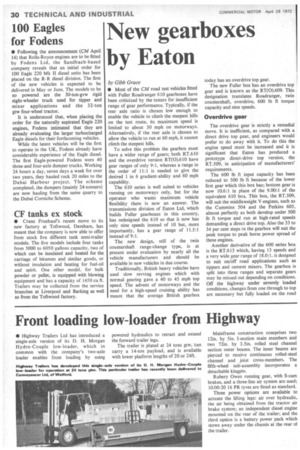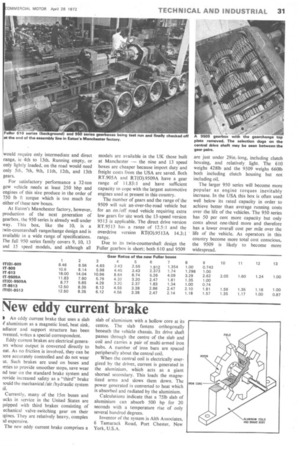New gearboxes by Eaton
Page 32

Page 33

If you've noticed an error in this article please click here to report it so we can fix it.
by Gibb Grace • Most of the CM road test vehicles fitted with Fuller Roadranger 610 gearboxes have been criticized by the testers for insufficient range of gear performance. Typically, if the rear axle ratio is chosen low enough to enable the vehicle to climb the steepest hills on the test route, its maximum speed is limited to about 50 mph on motorways. Alternatively, if the rear axle is chosen to allow the vehicle to run at 60 mph, it cannot climb the steepest hills.
To solve this problem the gearbox must have a wider range of gears; both RT.610 and the overdrive version RT(0).610 have gear ranges of only 9:1, whereas a range in the order of 11:1 is needed to give the desired 1 in 6 gradient-ability and 60 mph capability.
The 610 series is well suited to vehicles running on motorways only, but for the operator who wants maximum vehicle flexibility there is now an answer. The transmissions division of Eaton Ltd, which builds Fuller gearboxes in this country, has redesigned the 610 so that it now has only nine speeds instead of 10 but, more importantly, has a gear range of 11.5:1 instead of 9:1.
The new design, still of the twin countershaft range-change type, •is at present under evaluation by nearly all the vehicle manufacturers and should be available in new vehicles in due course.
Traditionally, British heavy vehicles have used slow revving engines which with normal gearing gave a 40 to 45 mph top speed. The advent of motorways and the need for a high-speed cruising ability has meant that the average British gearbox today has an overdrive top gear.
The new Fuller box has an overdrive top gear and is known as the RT(0).609. This designation translates Roadranger, twin countershaft, overdrive, 600 lb ft torque capacity and nine speeds.
Overdrive gear
The overdrive gear is strictly a remedial move. It is inefficient, as compared with a direct drive top gear, and engineers would prefer to do away with it. To do this the engine speed must be increased and it is significant that Eaton has produced a prototype direct-drive top version, the RT.509, in anticipation of manufacturers' requirements.
The 600 lb ft input capacity has been reduced to 500 lb ft because of the lower first gear which this box has; bottom gear is now 10.6:1 in place of the 9.00:1 of the equivalent 610 box. This box, the RT.509, will suit the middleweight V-engines, such as the Cummins 504 and the Perkins 605, almost perfectly as both develop under 500 lb ft torque and run at high-rated speeds demanding a direct drive top. Also the 33 to 34 per cent steps in the gearbox will suit the peak torque to peak horse power spread of these engines.
Another derivative of the 600 series box is the RT.613 which, having 13 speeds and a very wide gear range of 18.0:1, is designed to suit on/off road applications such as tippers and cement mixers. The gearbox is split into three ranges and separate gears may be missed out depending on conditions. Off the highway under severely loaded conditions, changes from one through to top are necessary but fully loaded on the road would require only intermediate and direct range, ie 4th to 13th. Running empty, or only lightly loaded, on the road would need only 5th, 7th, 9th, 11th, 12th, and 13th gears.
For satisfactory performance a 32-ton gcw vehicle needs at least 250 bhp and engines of this size produce M the order of 750 lb It torque which is too much for either of these new boxes.
At Eaton's Manchester factory, however,. production of the next generation of gearbox. the 950 series is already well under way. This box, like the 10, is a twin-countershaft rangechange design and is available in a wide range of specifications. The full 950 series family covers 9, 10, 13 and 15 speed models, and although all models are available in the UK those built at Manchester the nine and 13 speed boxes are cheaper because import duty and freight costs from the USA are saved. Both RT.905A and RT(0).9509A have a gear range of 11.83:1 and have sufficient capacity to cope with the largest automotive engines used at present in this country.
The number of gears and the range of the 9509 will suit an-over-the-road vehicle but for an on /off road vehicle requiring extra low gears for site work the 13-speed version 9513 is applicable. The direct drive version RT.95I3 has a range of 12.5:1 and the overdrive version RT(0).9513A 14.3:1 range.
Due to its twin-countershaft design the Fuller gearbox is short; both 610 and 9509 are just under 29in.-long, including clutch housing, and relatively, light. The 610 weighs 4281b and the 9509 weighs 6601b both including clutch housing but not including oil.
The larger 950 series will become more popular as engine torques inevitably increase. In the USA this box is often used well below its rated capacity in order to achieve better than average running costs over the life of the vehicles. The 950 series has 50 per cent more capacity but only costs about one-third more and therefore has a lower overall cost per mile over the life of the vehicle. As operators in this country become more total cost conscious, the 9509 is likely to become more widespread.








































































































